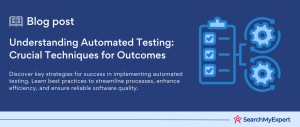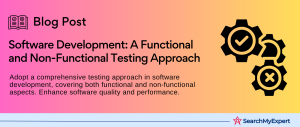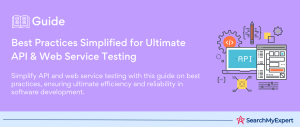Understanding Regression Testing: A Keystone in Software Development
In the dynamic realm of software development, regression testing emerges as a pivotal practice, essential for maintaining the integrity, functionality, and quality of software applications over time. This systematic approach to testing involves re-running functional and non-functional tests to ensure that previously developed and tested software still performs after a change. Whether these changes are enhancements, patches, or configuration adjustments, regression testing stands guard, ensuring that new bugs are not introduced into the existing codebase.
The Critical Role of Regression Testing
At its core, regression testing is not just a phase in the software development lifecycle; it is a strategic approach to quality assurance. Its importance can hardly be overstated, as it directly impacts the product’s reliability, user satisfaction, and the development team’s efficiency. By routinely conducting regression tests, teams can:
- Detect bugs early:
Identifying issues at the earliest possible stage saves time and resources. - Ensure software stability: Regular testing helps maintain the application’s stability by catching unintended consequences of new changes.
- Improve product quality:
Continuous reassessment through regression testing enhances the overall quality of the software product. - Facilitate continuous improvement:
It supports agile development practices by allowing for frequent changes while ensuring the application’s integrity.
The Risks of Neglecting Regression Testing
Neglecting regression testing is akin to sailing a ship without checking for leaks; it’s only a matter of time before the water seeps in. The potential risks include:
- Increased Bug Leakage:
Without regression testing, the chance of bugs slipping through to production significantly increases, leading to a poor user experience. - Higher Costs:
Identifying and fixing bugs at later stages of development or after deployment is often more time-consuming and costly. - Reduced Customer Satisfaction:
Frequent issues and failures can tarnish the product’s reputation and lead to dissatisfaction among end-users. - Delayed Releases:
The accumulation of unresolved issues can lead to delays in planned releases, affecting the overall timeline and market competitiveness.
Planning Your Regression Strategy
When it comes to ensuring the quality and reliability of software updates, a well-thought-out regression testing strategy is indispensable. This stage of testing is crucial for identifying unintended side effects caused by new changes or enhancements. By meticulously planning your regression testing approach, you can significantly reduce risks, improve software quality, and ensure a seamless user experience. In this section, we delve into various regression testing approaches, guide you on selecting appropriate techniques based on your project’s needs, and underscore the importance of prioritizing test cases for efficient regression execution.
Different Regression Testing Approaches
Regression testing can be approached in several ways, each with its unique advantages and applications. Understanding these methods is key to selecting the most effective strategy for your project:
- Equivalence Partitioning:
This technique involves dividing input data into equivalent partitions that the application should handle similarly. By testing a single representative from each partition, you can efficiently cover a wide range of inputs with fewer test cases. - Boundary Value Analysis (BVA):
BVA focuses on the values at the edges of equivalence partitions. Since software bugs are more likely to occur at these extreme values, BVA is an excellent method for uncovering potential issues at the boundaries of input ranges. - Decision Table Testing: This approach is useful for functions with logical relationships between inputs. By creating a decision table that covers all possible input combinations, testers can ensure comprehensive coverage and identify any unexpected behaviors.
- State Transition Testing:
For applications that exhibit different behaviors based on their state, state transition testing can be highly effective. This method tests the application’s transitions between states, ensuring that all state-related functionalities work as expected. - Use Case Testing:
Use case testing derives test cases from the use cases that describe real-world scenarios of how the application is used. This approach ensures that the software meets its intended functional requirements.
Selecting Appropriate Testing Techniques
Choosing the right regression testing techniques is crucial for effective and efficient testing. Consider the following factors when selecting your approach:
- Project Size and Complexity: Larger, more complex projects may benefit from a combination of testing techniques to cover various aspects of the software comprehensively.
- Risk Assessment: Identify the areas of the application that are most critical and prone to errors. High-risk areas may require more thorough testing approaches like boundary value analysis and decision table testing.
- Resource Availability:
Consider your team’s expertise and the time and resources available for testing. Equivalence partitioning and use case testing can be more straightforward and less resource-intensive. - Technology Stack: The technology used in the project can also influence your choice of testing techniques. For instance, state transition testing might be more relevant for applications with complex state management logic.
Prioritizing Test Cases for Efficient Regression Execution
Efficient regression testing requires careful prioritization of test cases to ensure that the most critical aspects of the application are tested first. Here’s how to prioritize effectively:
- Identify Critical Functionalities:
Start by identifying the core features and functionalities that are vital to the application’s operation. These should be tested as a priority. - Assess Impact of Changes:
Understand the impact of recent changes on the application to prioritize testing in affected areas. - Consider User Feedback:
Feedback from users can highlight areas that are more prone to issues or are of high importance to the end-user experience. - Use Risk-Based Prioritization: Allocate testing efforts based on the risk level of different application components. High-risk areas should be tested more thoroughly and frequently.
Establishing an Automated Testing Framework
The evolution of software development methodologies towards more frequent releases demands an efficient approach to regression testing. Automation stands out as a pivotal solution, offering speed, accuracy, and repeatability in executing regression tests. This section outlines the benefits of automating regression tests, explores various tools and frameworks available for automation, and provides actionable tips on designing effective and maintainable automated test scripts.
Benefits of Automating Regression Tests
Automating regression tests brings a plethora of advantages that can significantly enhance the efficiency and reliability of the testing process:
- Speed:
Automated tests can be executed much faster than manual tests, enabling teams to run comprehensive test suites frequently and at any time, thereby accelerating the development cycle. - Accuracy: Automation reduces the risk of human error, ensuring that tests are performed consistently and accurately every time they are run.
- Repeatability:
Once created, automated tests can be reused across different versions of the software, ensuring that previous functionalities continue to work as expected after new changes are introduced. - Efficiency:
Automation allows testers to focus on more complex testing tasks and exploratory testing, while routine checks are handled by the automated tests. - Coverage:
Automated testing can easily cover a vast number of test cases, including complex scenarios, increasing the overall quality of the software.
Exploring Automation Tools and Frameworks
Selecting the right tools and frameworks is crucial for effective automation. Here’s a brief overview of some popular options available in the market:
- Selenium:
A widely used framework for web application testing, Selenium supports multiple programming languages and browsers, offering flexibility in automation script development. - Appium: For mobile application testing, Appium is a go-to choice. It allows for cross-platform testing, supporting both Android and iOS applications.
- TestComplete:
A comprehensive tool that supports desktop, mobile, and web application testing. TestComplete is known for its user-friendly interface and powerful scripting capabilities. - Cypress: A modern web testing framework that is gaining popularity for its ease of use and fast execution. Cypress is especially suited for end-to-end testing.
- JUnit/TestNG for Java applications: These frameworks are essential for unit testing in Java development, providing annotations and assertions to streamline the testing process.
Designing Effective and Maintainable Automated Test Scripts
Creating automated test scripts that are both effective and easy to maintain requires careful planning and execution. Here are some tips to guide you:
- Follow Best Practices in Coding: Write clean, readable, and modular code. Use comments and consistent naming conventions to make your test scripts easily understandable.
- Prioritize Maintainability:
Design your tests to be easily maintainable, considering the future changes in the application. Use page object models and other design patterns to reduce the effort needed to update tests when the application UI changes. - Data-Driven Testing: Implement data-driven testing to separate test logic from test data. This approach allows you to easily update test data without altering the test code, making your tests more flexible and reusable.
- Continuous Integration (CI):
Integrate your automated tests with a CI pipeline to run them automatically with every code commit. This practice helps in identifying and fixing regressions early in the development cycle. - Regularly Review and Refactor:
As the application evolves, regularly review and refactor your test scripts to ensure they remain relevant and efficient. Remove obsolete tests and update existing ones to reflect changes in the application.
Efficient Test Execution and Reporting
Efficient test execution and robust reporting mechanisms are cornerstone elements for the success of a regression testing strategy. They not only ensure that tests are run effectively but also that the results are communicated clearly to all stakeholders. This section will discuss strategies to optimize the test execution process, highlight the importance of clear and concise test reporting, and recommend tools and techniques for effective result tracking and reporting.
Strategies for Optimizing the Test Execution Process
To maximize the efficiency of the regression testing process, several strategies can be employed:
- Parallel Testing:
Running tests in parallel, across multiple environments or machines, can significantly reduce the time required for test execution. This approach is particularly effective when dealing with a large suite of test cases. - Continuous Integration (CI): Integrating regression tests into a CI pipeline ensures that tests are automatically executed with every code commit or at scheduled intervals. This facilitates early detection of issues and keeps the development team informed about the current state of the software.
- Test Prioritization:
Prioritizing tests based on factors such as criticality of the feature, impact of recent changes, and historical data of bug occurrences can help in focusing efforts on the most important tests first. - Test Selection: Implementing smart test selection techniques, such as risk-based testing or change-based testing, can help in identifying which tests are most relevant to run for a particular set of changes, thus saving time and resources.
- Environment Management: Ensuring that test environments are properly managed and can be quickly set up or torn down contributes to the overall efficiency of the testing process. Containerization and virtualization technologies can be particularly helpful in this regard.
The Importance of Clear and Concise Test Reporting
Clear and concise test reporting is crucial for effective communication with stakeholders. It provides insights into the quality of the software, highlights potential issues, and aids in decision-making processes. Good reporting should:
- Highlight Key Metrics: Focus on key metrics such as the number of tests executed, passed, failed, and skipped, as well as coverage statistics and trends over time.
- Be Accessible: Reports should be easily accessible and understandable by all stakeholders, regardless of their technical background. Visual representations like graphs and charts can be particularly effective.
- Facilitate Decision Making:
Provide actionable insights that help stakeholders make informed decisions regarding the release readiness of the software and areas that may require additional attention. - Include Detailed Logs:
For failed tests, detailed error logs and possibly screenshots or videos can help developers quickly identify and address issues.
Tools and Techniques for Effective Reporting and Tracking Test Results
Several tools and techniques can enhance the reporting and tracking of test results:
- Test Management Tools:
Tools like TestRail, Zephyr, and qTest offer comprehensive test management capabilities, including test planning, execution, and detailed reporting. - CI/CD Platforms:
CI/CD platforms like Jenkins, CircleCI, and GitLab CI provide built-in features for test execution and reporting within the continuous integration and deployment pipelines. - Dashboard and Analytics Tools:
Dashboards and analytics platforms such as Grafana or Kibana can be used to create custom visualizations of test data, making it easier to monitor trends and identify issues over time. - Logging and Monitoring Tools: Integrating logging and monitoring tools like ELK Stack (Elasticsearch, Logstash, Kibana) or Splunk can help in capturing detailed logs and performance metrics from test executions, aiding in troubleshooting and analysis.
Measuring and Improving Regression Testing Effectiveness
To ensure the continued reliability and efficiency of software development processes, it’s essential to measure and improve the effectiveness of regression testing continually. This final section explores key metrics for assessing regression testing performance, discusses strategies for continuous improvement based on data and feedback, and encourages the adoption of best practices learned from project experiences.
Key Metrics for Measuring Regression Testing Effectiveness
Several metrics can help teams gauge the effectiveness of their regression testing efforts:
- Test Coverage:
Measures the extent to which the source code is executed when the test suite runs. High test coverage indicates that a large portion of the codebase is tested, reducing the risk of undetected defects. - Defect Detection Rate:
The number of defects detected during regression testing compared to the total number of defects found after release. A high detection rate suggests that regression testing is effective at catching defects before they reach production. - Test Execution Time:
Tracks the time taken to execute the regression test suite. Optimizing test execution time without compromising coverage is crucial for maintaining agility in the development process. - Defect Escape Rate:
The ratio of defects discovered after release to those found during testing. A low escape rate indicates that the regression testing is effectively identifying and allowing the team to fix defects before they impact end users. - Test Case Effectiveness:
Assesses the proportion of test cases that lead to the discovery of defects. This metric helps in identifying and focusing efforts on the most productive test cases.
Strategies for Continuous Improvement
Leveraging the data collected through these metrics, teams can implement strategies for continuous improvement:
- Regular Reviews and Adjustments:
Conduct regular review sessions to assess the performance of the regression testing process. Use metrics as a basis for discussing what’s working and what needs improvement. - Feedback Loops:
Establish feedback loops with developers, testers, and stakeholders to continuously refine the testing process based on real-world experiences and outcomes. - Automation Optimization:
Continually evaluate the test suite for opportunities to increase automation. Automating repetitive and time-consuming tests can free up resources for more complex testing scenarios. - Training and Skill Development: Invest in training and development for team members to stay updated on the latest testing methodologies, tools, and best practices.
- Implementing Lessons Learned:
Document lessons learned from each project and incorporate these insights into future testing strategies. This can include adjustments to test case design, execution schedules, and prioritization criteria.
Learning and Adapting Best Practices
Adapting and evolving regression testing practices based on project experiences is key to maintaining their effectiveness. Encourage a culture of continuous learning within the team, where insights and experiences are shared openly. This not only helps in refining the testing process but also fosters innovation and collaboration among team members.
Conclusion
Effective regression testing is pivotal in ensuring that software applications remain reliable and high-performing amidst continuous changes and updates. Through meticulous planning, execution, and constant refinement, regression testing safeguards against unexpected defects, thereby upholding the software’s quality and user satisfaction. This comprehensive guide has walked you through the essential steps to optimize your regression testing strategy, from planning and automation to execution, defect management, and continuous improvement.
Guide your software to success with our Software Testing Service Company.
Table of Contents
Toggle






